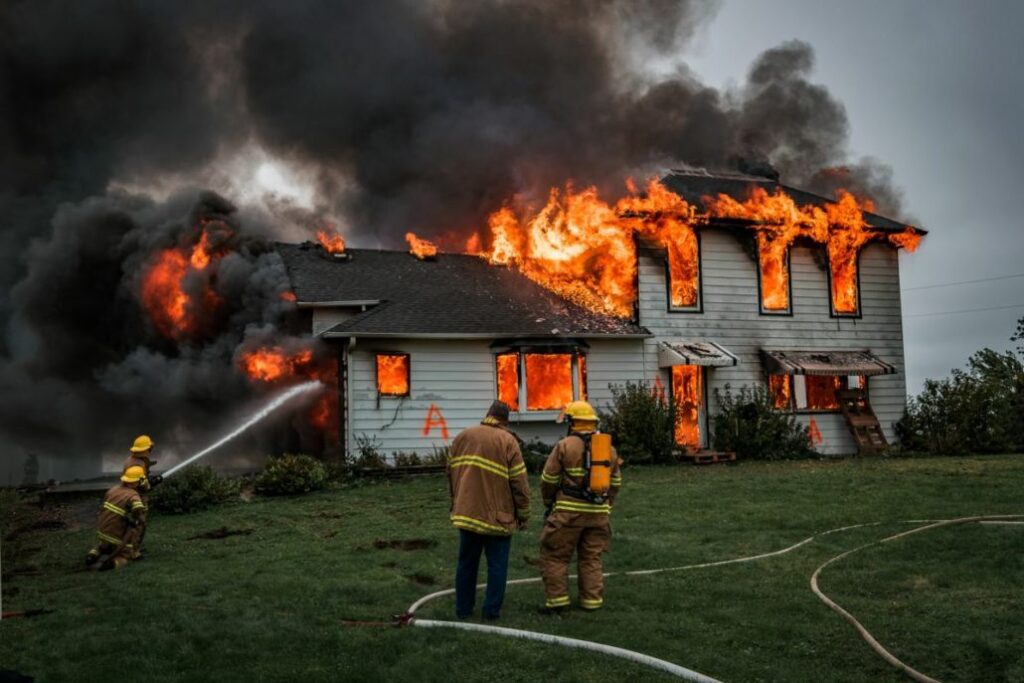Common Home Insurance Claims and How to Prevent Them

You buy homeowner’s insurance to protect yourself from expensive losses. And as a savvy consumer, you know that too many claims on your home insurance policy can lead to increased premiums, difficulty finding affordable insurance, and even non-renewals.
No one wants to struggle to find affordable homeowner insurance. That’s why it’s vital to learn about the most common home insurance claims and ways you can prevent them.
Today, our team of licensed insurance agents explains everything there is to know about the most common home insurance claims, including the most recent home insurance claims statistics we can find.
Read on to learn about:
Let’s begin with a look at various types of home insurance claims.
Types of Home Insurance Claims
There are several ways we could group various types of homeowner’s insurance claims. For the purpose of this piece, we’ll begin by dividing them into two groups:
Property damage claimsAnd liability claims
Most common home insurance claims deal with property damage.
The Most Common Homeowner Insurance Claims
When considering which insurance claims are most common, the Insurance Information Institute (III) counted the actual number of claims made over a period of four years.
But remember, the number of claims made is distinct from the amounts paid on claims, and we’ll get into those statistics shortly.
Common Property Damage Claims
Let’s begin by describing types of property damage that could happen at your home. Remember, your policy covers points like:
Fire and smoke damageWind damageLightningCivil unrest and riotsPlane crashesMalicious mischief and vandalism
Most home insurance policies do not cover earthquakes or flooding, those coverages will require added policies or endorsements.
According to the III, nearly 98% of all home insurance claims deal with property damage.
The table below was published by the III in 2023. Note that 2023 home insurance claims aren’t yet available.
Looking closely at the III table, you’ll notice that wind and hail cause the most claims in the US every year, with around 40% of all home insurance claims resulting from those perils.
Next, you’ll discover that water damage and freezing account for 19% to 27% of all claims in a given year.
Lightning and fire are also common home insurance perils, followed by theft, and all other property damage claims.
Cause of loss20182019202020212022Property damage (2)97.4%96.7%97.2%97.0%97.8%Wind and hail40.538.348.339.840.7Water damage and freezing24.029.019.623.427.6Fire and lightning25.421.121.123.321.9Theft1.01.00.60.70.7All other property damage (3)6.57.27.69.86.9Liability (4)2.5%3.3%2.8%2.9%2.1%Bodily injury and property damage2.32.92.42.41.6Medical payments and other0.20.40.40.50.5Credit card and other (5)0.10.10.10.10.1Total100.0%100.0%100.0%100.0%100.0%
Next, we can consider the liability claims information.
Common Liability Claims
In the language of “insurance-speak” or “legalese,” remember that liability means responsibility. Liability claims often arise when someone is injured on your property. And, depending on your policy, things like identity theft and credit card theft may be covered by this part of your home insurance.
Viewing the table above, you’ll notice that liability claims, medical payments to others and credit card issues are far less common home insurance claim topics. In fact, only about 2% of home insurance claims made have to do with liability.
And very few claims calls relate to credit card theft.
The bottom line is this: as a homeowner, you’re much more likely to call in a claim for hail damage than an injured guest.
Now, let’s talk about ways you can reduce your risks as a homeowner, to prevent most common home insurance claims.
Methods for Preventing Home Insurance Claims
Not every home insurance claim is preventable. If damage to your property was that easy to prevent, there would be no need for insurance!
No one can control the weather, prevent hail damage, or send a lightning bolt over to the rudest neighbor’s house. But there are many ways we can behave proactively to prevent home insurance claims.
We can:
Create a defensible space to prevent wildfire damage (you can learn more on that, below)Stay sober when cooking or grilling outsideKeep holiday parties under control, limit drinking or irresponsible behavior by guestsPurchase fire extinguishers, and keep them up-to-dateInstall carbon monoxide detectors and check the batteries occasionallyInvest in home security systems to prevent theft or other mischiefRemove dead trees or tree limbs around your propertyStack firewood well away from the houseInvest in sprinkler systemsKeep porches and patios safe, and in good repairOnly keep safe pets, no wild animals
Creating Defensible Space in Areas Prone to Brush Fires
If you live in a wildfire-prone region, take the time to create defensible space around your residence and outbuildings.
Defensible space acts like a buffer between your structures and fire outside. Start by looking at a 100-foot perimeter around your home. Can you see dead brush, dried grasses or fallen limbs? Remove any dead plant matter, that stuff burns fast and furious.
Trim the lower limbs on large trees, so a low brush fire cannot catch there. And remember, you want the area to be “clean and green.” If a tree should die, remove it right away.
Now you might be thinking, “I have neighbors closer than 100 feet, and they have fire risks on the property. What do I do?”
What About Your Neighbor’s Fire Risks?
Does your neighbor have dead trees, fallen limbs, or stacks of firewood on your fence? It happens, but you still need to do your best to prevent a fire claim.
Start with a friendly conversation with your neighbor. This may seem easier said than done, we understand. If you’re like 57% of Americans you don’t know all your neighbors. In that case, you could knock on their door, invite them over for a beverage, or carry a plate of cookies to their house to break the ice.
Then, explain your concerns about fire risk and insurance issues. Offer to help if possible. Some people are completely aware of fire risks on their property but are physically unable to do anything about them.
What if Your Neighbor is a Jerk?
If things aren’t friendly between you and your neighbor, this may be a good reason to change the dynamic. No one wants a fire in the neighborhood! Try the beverage/cookie approach, and explain that you’d like to help, for the sake of the entire neighborhood.
If your neighbor won’t answer the door at all, try a pleasant phone call. Then, send a polite note in the mail. Whatever you do, don’t “put your neighbor on blast” on social media. That won’t be helpful at all and will probably make the relationship deteriorate more.
Remember, a fire next door will likely cause some sort of damage to your property, and your insurance premiums could increase after a claim. That might help you bury the hatchet.
Be Proactive when Disaster Strikes (Safely)
It should go without saying that your safety — and that of your family — should always be your top priority. Still, insurance companies expect you to do your best to mitigate claim damage when it happens.
In other words, you should take active steps to reduce damage during an event. That might mean tarping your roof after hail damage or boarding up a broken window during a hurricane. These actions won’t completely prevent a claim, but they will reduce the overall damage.
Remember to take photos and keep receipts for anything you buy during this process. It helps prove your efforts, and your insurer will reimburse you for things like tarps, hammers, nails, plywood and so on.
Now, let’s switch gears and talk about some interesting home insurance statistics, and how they relate to modern living in America.
Interesting Home Insurance Claims Statistics and Other Points
If you’ve read this far, you know that hail is the most frequent cause for homeowner’s insurance claims. But the most expensive home insurance claims are house fires, and they often include a lightning element.
According to the III, fire and lighting claims payments average about $83,000 each. Fires can cause a lot of damage quickly! And the smoke damage can be considerable, too.
Thankfully, many fires don’t lead to a total loss. In other words, a kitchen fire may only destroy one room of your home (while causing smoke damage in other rooms.)
The number of fire claims continues to grow, too. Per the National Fire Prevention Association (NFPA):
In 2022, fire departments responded to about 1.5 million home fires in the US.An injury in a home fire occurs every 53 minutes, and a home fire death occurs every 3 hours and 14 minutes.
On the interesting, thought-provoking side, some researchers speculate that COVID-19 has caused more people to cook at home often. They believe this may be leading to more kitchen fires.
While fires may be the most expensive claims, dog bites and other animal attacks are happening more often in the US, leading to more liability claims.
Dog Bite Claims are Increasing
Insurance Journal recently reported that US insurance companies paid out $1.12 billion in dog-related injury claims in 2024. There was a total of 19,062 dog bite claims last year, and that’s an 8% increase over 2022. Overall, that’s a 110% increase over the past decade.
We don’t think dogs are becoming any meaner. We believe people are becoming more eager for a fast payout, and a dog bite injury could be a quick way to make money.
If you do have a large dog, make sure he’s well trained and make sure your fence is sturdy. Some people like to post signage that says “beware of dog.” Others feel this invites a litigious individual to provoke your dog into misbehaving, and that’s something to consider.
Also, be aware that some home insurance policies now include dog bite exclusions. In other words, your contract might specifically say that dog bites are not covered. Remember to read your policy closely for details like this.
Lastly, it’s time to discuss the costs of home insurance claims.
The Costs of Home Insurance Claims
When disaster strikes, the first financial hit is taken by the insurer. In a single incident, like a kitchen fire that costs $83,000 on average, the ongoing costs may be limited and relatively small.
Chances are, however, the insured individual who made the claim will pay higher insurance premiums from now on. That could go on for years.
Premiums Will Increase After Several Claims
And if an insured calls in several claims over a few years, their home insurance costs could skyrocket. It might become very difficult to find affordable homeowner’s insurance, especially in a volatile market like those we see right now in Florida and California.
Research published by The Zebra suggests that:
After one home fire, insurance costs will increase by about 21%After a second fire, prices increase another 4%And after a third fire, expect to pay another 3%
Insurers share very detailed claims information with each other, by the way. So, if you’re shopping around for insurance after several claims, it’s best to be honest about your history. Otherwise, insurance companies will think you’re dishonest and be reluctant to insure your home.
Premiums Can Increase in an Entire Neighborhood, Too
Sometimes, after regional events or larger disasters, homeowner insurance premiums can increase for everyone in the neighborhood. Even if you’ve never had a single claim, if a major fire strikes your zip code, your insurance costs will increase. (And that’s all the more reason to get friendly with your neighbors to tackle those fire risks.)
Ultimately, remember that insurance exists to protect you against these risks. But this protection and peace of mind does come at a cost.
If you’re interested in finding more affordable home insurance — and even if you have several claims — we can help. Check out our online quoting tool today to learn more.



